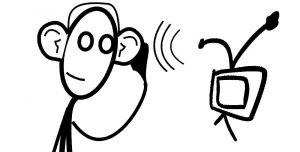IBC 2015 Demonstration of Object Based Clean Audio
 The problems of hearing impaired people watching TV have been well documented of late. Loud music, background noise and other factors can ruin the enjoyment of TV for many people with hearing loss – around 10 million people in the UK according to Action on Hearing Loss.
The problems of hearing impaired people watching TV have been well documented of late. Loud music, background noise and other factors can ruin the enjoyment of TV for many people with hearing loss – around 10 million people in the UK according to Action on Hearing Loss.
In previous research funded by the ITC and Ofcom I looked at solutions that took advantage of the (then) recent introduction of 5.1 surround sound broadcast. Some of this ended up in broadcast standards and is being used by broadcasters. Now emerging new audio standards are opening the door to improving TV sound much more for hearing impaired people, and also for many others.
I’ve written about some of this work before, a recent blog post described our journal article in the Journal of the Audio Engineering Society where my colleague Rob Oldfield and I picked up where my PhD left off and looked at how we could improve TV sound for hearing impaired people by using features of emerging object-based audio formats. In object-based audio all component parts of a sound scene are broadcast separate and are combined at the set top box based on metadata contained in the broadcast transmission. This means that speech, and other elements important to understanding narrative, can be treated differently compared to background sound (such as music, noise etc).
I’ve just returned from IBC in Amsterdam where we’ve been demonstrating some University of Salford research outputs on object-based clean audio with DTS, a key player in object-based audio developments.

IBC 2015: The largest global electronic media and entertainment show in Amsterdam last week.
Object-based Clean Audio at IBC 2015
Last week we spent a week showing the results of our recent collaboration with DTS – presenting personalised TV audio and Continue reading →










